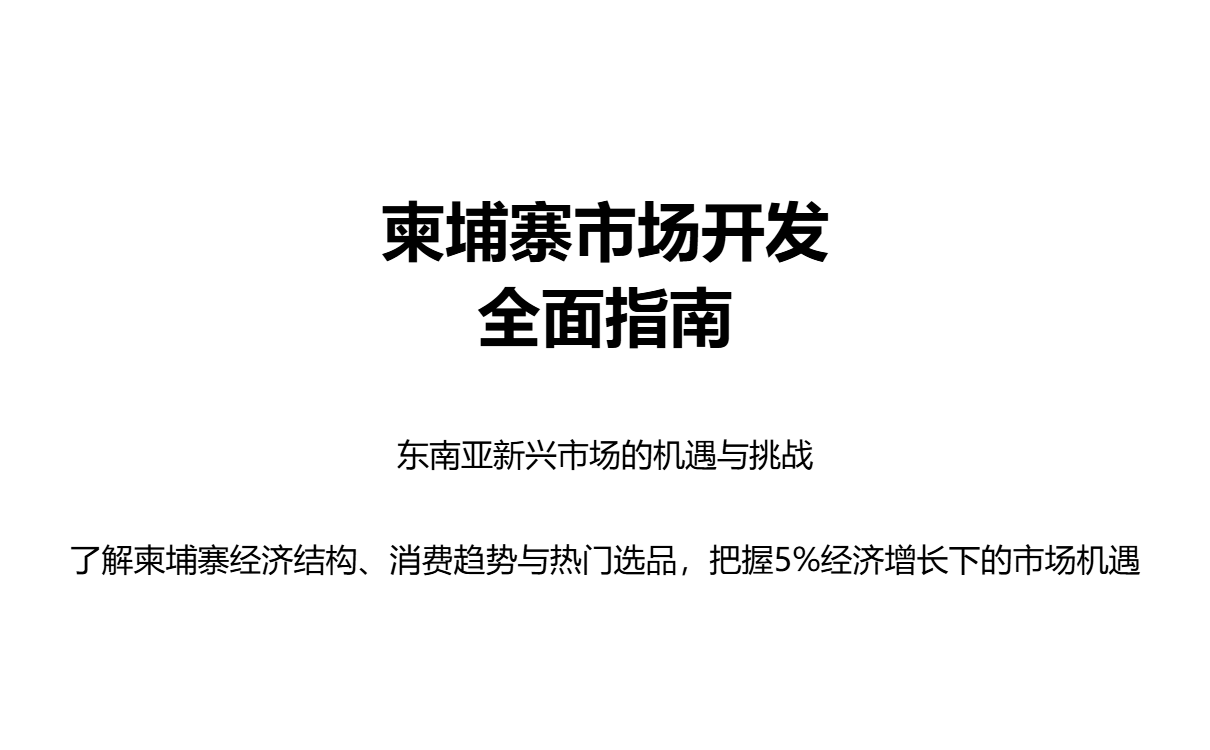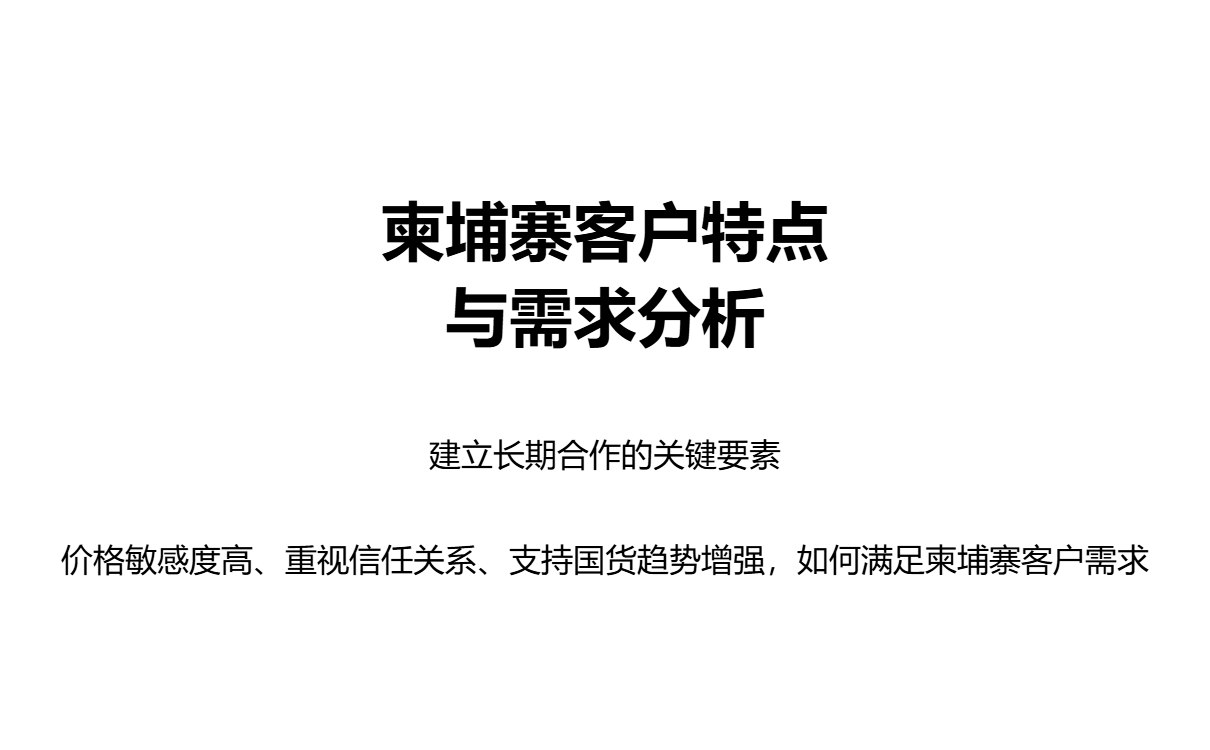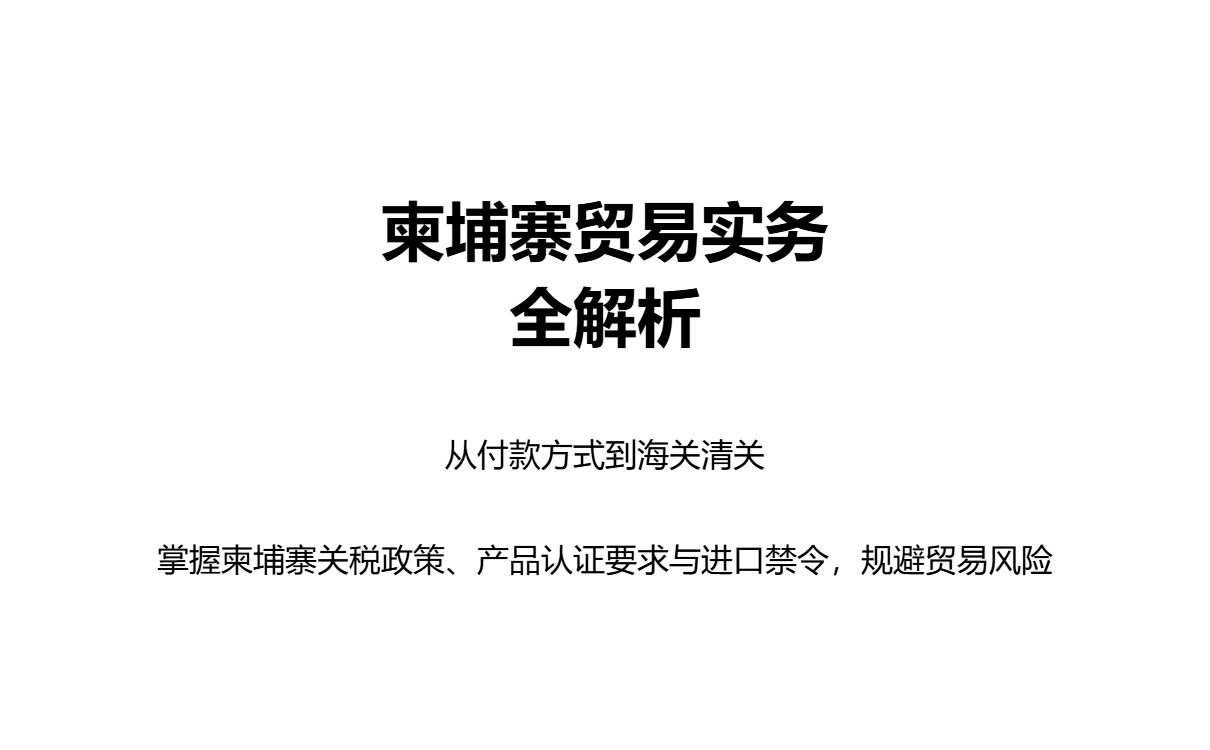
Cambodia, located in the Indochina Peninsula of Southeast Asia, is a rapidly developing country. For foreign traders, understanding its basic national conditions is the first step in market development.
Country name : Kingdom of Cambodia
Area : approximately 180,000 square kilometers
Population : Approximately 17 million (2023 estimate)
Religion : Theravada Buddhism is the state religion, accounting for about 97% of the population
Official language : Khmer, English and French are also widely used in business and government agencies, and Chinese is popular in Chinese communities
Capital : Phnom Penh, the country's political, economic and cultural center
Economic situation :
Cambodia's economy maintains steady growth. Despite facing external challenges, it is projected to reach 5% growth in 2025. Per capita GDP continues to rise, from US$2,520 in 2023 to US$2,713 in 2024, and is projected to reach nearly US$3,000 in 2025, demonstrating a steady increase in residents' purchasing power.
Economic pillars :
Cambodia's economy mainly relies on five pillar industries: clothing and footwear, travel goods exports, tourism, agriculture, and real estate and construction.
Industry : Mainly clothing, non-clothing manufacturing and construction, expected to grow by 7.1% in 2025
Agriculture : A traditional advantageous industry, with an expected growth rate of 0.9% in 2025. Rice, natural rubber, cashew nuts, etc. are the main agricultural products
Services : Mainly tourism, transportation, telecommunications, trade and real estate, expected to grow by 3.8% in 2025
Tourism : World cultural heritage sites such as Angkor Wat are major tourist attractions and are steadily recovering from the epidemic.
Resources : Rich in forestry and fishery resources, and mineral resources include gold, copper, bauxite, etc.
Foreign Trade :
Cambodia's exports are primarily clothing, footwear, and agricultural products, while its imports primarily include textile raw materials, machinery and equipment, petroleum products, automobiles, and consumer goods. Its major trading partners include China, the United States, the European Union, Vietnam, and Thailand.
Foreign capital :
Cambodia's advantages in attracting foreign investment include low labor costs, a young population, and its central location in the Greater Mekong Subregion, which connects Laos, Vietnam, Thailand, Myanmar, and southern China, with a total population of over 250 million . Foreign investment primarily flows into garment processing, construction, tourism, and agriculture.
China-Cambodia bilateral trade :
China is Cambodia's largest trading partner and source of investment. In April 2025, the two countries signed a cooperation document in the fields of metrology, standardization, and conformity assessment, laying the foundation for further facilitation of bilateral trade.

Understanding Cambodia’s festivals and customs is crucial for planning business trips and marketing activities.
Major festivals :
Cambodia's festivals are mostly related to Buddhist traditions and national anniversaries. The following is an overview of the main festivals:
| Festival Name | Approximate time | Features and Business Tips |
|---|---|---|
| International New Year | January 1 | Statutory holidays, business activities suspended |
| Victory Day | January 7 | Commemorating the fall of the Khmer Rouge regime |
| International Women's Day | March 8 | Normal business hours |
| Buddhist New Year | April 13-16 | The most important traditional festival , celebrated for 3 consecutive days |
| International Labor Day | May 1 | statutory holidays |
| Pizza Plantain Festival | May | Buddhist Festivals |
| King's Birthday | May 13-15 | King's Birthday, a public holiday |
| National Day | June 18 | Commemorating the former King Norodom Sihanouk |
| Constitution Day & National Assembly Elections | September 24 | Political Anniversary |
| All Souls' Day | September/October | Buddhist festival, lasting 15 days |
| Paris Peace Agreement Anniversary | October 23 | Political Anniversary |
| Independence Day | November 9 | Important national holidays |
| Water Festival | October/November | traditional festivals |
| Christmas | December 25 | Informal festival |
Customs and taboos :
New Year customs : During Cambodia's traditional New Year (usually in April), people splash water and sprinkle powder on each other to express good wishes. Be careful when traveling during this time, as you might get your clothes wet due to the "blessings."
Chinese Zodiac Culture : Cambodia also has twelve Chinese zodiac animals, which are roughly the same as those of China. The difference is that Cambodia replaces the dragon with the seven-headed giant snake Naga and takes the ox as the first of the twelve Chinese zodiac animals .
Red envelope culture : Cambodians have the custom of giving out "red envelopes". During festive occasions such as the Spring Festival, businesses often prepare red envelopes for employees or partners as a blessing.
Business Etiquette : Cambodians value formality and often greet each other with a simple gesture of joining hands. In business interactions, it's important to be humble and patient, and avoid speaking loudly or acting impatiently.
Note : Buddhism is the state religion of Cambodia, and monks should be respected; the head is considered a sacred part, so do not touch other people's heads; do not point at people or objects with your feet.
Economic growth is stable and purchasing power continues to increase
Cambodia's economy maintains steady growth, with a projected 5% increase in 2025. Per capita GDP is projected to rise from US$2,713 in 2024 to nearly US$3,000 in 2025, indicating increasing purchasing power and expanding consumer market potential.
Influenced by the external environment, opportunities are sought in structural adjustments
Cambodia's economy faces several challenges in 2025, primarily due to dual external factors: the Cambodia-Thailand border conflict and increased US tariffs. Effective August 1, 2025, the US will impose a 19% tariff on Cambodian goods, putting pressure on Cambodian exports.
However, these challenges also bring market transformation and new opportunities:
Awakening of local consciousness : After the Cambodia-Thailand conflict, Cambodian people's consumption tendencies have changed, and they are more inclined to support domestic brands and products , providing opportunities for cooperation between Chinese companies and local companies.
Deepening multilateral trade relations : Cambodia actively participates in regional economic cooperation, expanding its market through the Regional Comprehensive Economic Partnership (RCEP) and the China-Cambodia Free Trade Agreement. Cambodia also announced a zero-tariff policy for all goods imported from the United States, potentially creating room for imports of alternative products from China.
As industrial upgrading progresses, the industry is transforming from "high output" to "high value"
Taking the cashew industry as an example, Cambodia's cashew production reached 850,000 tons, a year-on-year increase of 26.8%. However, over 90% of this is exported to Vietnam as raw materials, placing it at the low end of the value chain. The Cambodian government is promoting industrial upgrading, including through the "National Cashew Policy 2022-2027," with the goal of establishing Cambodia as a leading global cashew production and export hub. This transformation trend is evident across all industries, creating opportunities for Chinese companies providing machinery, equipment, and technical support.

Customer characteristics :
High price sensitivity : Cambodian customers are more sensitive to prices, and the order volume may be small but stable.
Communication preference is social : They prefer to communicate through social media, such as Facebook, Telegram, etc.
Emphasis on trust and relationships : Cambodian business culture values personal connections and trust, and establishing good personal relationships is the basis for long-term cooperation.
The trend of supporting domestic products is strengthening : After the recent Cambodia-Thailand conflict, the consumption tendencies of Cambodian people have changed, and they are more inclined to support domestic products and brands.
Characteristics of consumer demand :
Pursuit of cost-effectiveness : While maintaining price competitiveness, there are also basic requirements for quality.
Gradual acceptance of high-end products : As the middle class expands, the demand for high-quality consumer goods is also growing.
Increased acceptance of digitalization : The younger generation in particular is more receptive to new forms of payment, e-commerce shopping, and so on.
Based on Cambodia's economic structure and consumption trends, the following categories present significant market opportunities:
Industry and means of production
Light industrial machinery and equipment : Cambodia's industrial development requires a large amount of production equipment, especially equipment for garment processing, agricultural product processing and building materials manufacturing.
Building materials and hardware : Cambodia's construction industry continues to develop, with strong demand for building materials, hardware tools and decorative materials.
Power equipment : Cambodia's power infrastructure is still being improved, and there is a continuous demand for power transmission and transformation equipment, power generation equipment and new energy products.
Consumer electronics
Smartphones and accessories : Cambodia has a high mobile Internet penetration rate, and there is a great demand for smartphones and related accessories.
Computers and peripherals : With the progress of digitalization, the demand for desktop computers, laptops, USB flash drives, mobile hard drives and other accessories is increasing.
Agriculture and food processing
Agricultural product processing equipment : Cashew processing equipment is a hot investment area. You can pay attention to mechanical equipment for drying, sorting, packaging and other links.
Agricultural inputs : The demand for agricultural production materials such as high-quality seeds, pesticides, and fertilizers is stable.
Consumer Goods and Lifestyle
Household products : As living standards improve, the demand for products that improve the quality of life, such as kitchenware, home textiles, and small appliances, increases.
Beauty and Personal Care : Consumption of skin care products, makeup and personal care products continues to rise.

Cambodian customers use a variety of payment methods in cross-border trade. Understanding the characteristics of each method will help you provide payment options that are more in line with local customs.
The following is a comparison of cross-border payment methods commonly used by Cambodian customers:
| Payment Methods | Fee ratio | Arrival time | Security Level | Appropriate quota range | Features |
|---|---|---|---|---|---|
| PayPal | 3-5% | 3-5 days | ★★★★☆ | $50-$5000 | Supports 200+ countries and handles refund disputes quickly |
| Alipay+ & WeChat Cross-border Edition | 1-2% | 1-2 days | ★★★☆☆ | $20-$2000 | Payment is convenient in Asia and the fees are low |
| Local bank transfer | $15 fixed fee | 5-7 days | ★★★★★ | $500+ | High security, suitable for large transactions |
| Cryptocurrency | 0.5-1% | Real-time | ★★☆☆☆ | Unlimited | Fast arrival but higher risk |
| MoonPay Solution | Check the redemption platform | 1 hour | ★★★☆☆ | $100+ | Combining e-wallets and cryptocurrencies |
Select suggestion :
For small transactions , Alipay+ or WeChat cross-border version are recommended, as they have lower transaction fees.
For large transactions (over US$500), although cross-border transfers through local banks take longer to arrive, they are highly secure and the fixed fees are relatively small.
For first-time transactions with new Cambodian customers, we recommend using PayPal due to its comprehensive buyer protection mechanism.
Developing the Cambodian market requires a multi-channel approach, combining online and offline methods to find potential customers.
Comprehensive strategy :
Developing the Cambodian market requires a combination of online and offline channels. In the early stages, initial contacts can be established through social media. In the mid-term, consider participating in industry exhibitions for face-to-face communication. In the later stages, local representative offices can be established or agency channels can be sought to deepen market penetration.
Cambodia's product certification system is constantly being improved, and Chinese exporters need to pay attention to relevant requirements.
Standards and Conformity Assessment :
In April 2025, China and Cambodia signed a memorandum of understanding on cooperation in standardization and conformity assessment. This cooperation lays the foundation for the two countries to coordinate standards and mutually recognize conformity assessment results, which will help reduce trade barriers.
Common product certification requirements :
Electronic and electrical products : They need to comply with Cambodian standards, and some products may require safety certification.
Food and agricultural products : Health permit, certificate of origin and inspection and quarantine certificate are required.
Cosmetics : Product ingredient description and safety certification are required.
Medicines and medical devices : Require registration and approval from the Cambodian Ministry of Health.
Practical suggestions :
Confirm the certification requirements for specific products with Cambodian importers, as some products may be subject to ASEAN harmonized standards.
Follow the latest developments in cooperation between China and Cambodia and take advantage of increasingly facilitated certification procedures.
Export process :
Prepare basic documents such as export contracts, commercial invoices, packing lists, bills of lading, etc.
Obtaining a certificate of origin, such as Form E, can provide you with preferential tariffs.
Arrange cargo transportation and insurance
After the goods arrive at the port, the buyer picks up the goods with the bill of lading
The buyer handles import customs clearance and pays relevant taxes and fees
Customs clearance type :
General trade customs clearance : applicable to most commercial goods
Temporary import : for exhibition samples, equipment temporarily entering the country, etc.
Re-export trade : Cambodia can also serve as a re-export trade base
Customs clearance process and requirements :
Cambodia's customs clearance process includes declaration, valuation, inspection, and tax payment. According to a notice from the General Department of Customs and Taxation of Cambodia, with the exception of certain restricted goods, all other goods can be imported normally in accordance with existing laws and procedures.
Specific requirements :
Accurate classification : Correct classification according to the Harmonized System (HS) code
Complete documents : Provide complete trade documents
Truthful declaration : the declared value must be consistent with the actual transaction value
Beware of restrictions : Understanding Cambodia’s import bans and restrictions
Import ban :
According to the announcement of the General Department of Customs of Cambodia on July 16, 2025, the Thai products currently subject to import restrictions include:
Vegetables and fruits
A variety of fuel and gas options, including:
gasoline
diesel fuel
Liquefied Petroleum Gas and Liquefied Natural Gas
heavy oil
aviation fuel
It is worth noting that, in addition to the commodities listed above, other commodities are not prohibited from import. Merchants and traders can still handle import procedures normally in accordance with existing laws and procedures.
Export Ban :
Cambodia has implemented export restrictions on some commodities, mainly including:
Logs and some wood products
Precious cultural relics and artworks
Some wild animals and their products
Understanding Cambodia’s tariff policy is crucial for foreign traders. The following is key information:
Tariff system :
Cambodia uses the internationally accepted Harmonized System (HS) codes to classify imported goods. Tariff rates vary depending on the type of goods, ranging from duty-free to a maximum of 35% . .
Latest changes in 2025 :
Comprehensive Duty-Free Policy for US Goods : In response to US tariff adjustments on Cambodia, the Cambodian government announced a zero-tariff policy for all US imports starting August 1, 2025. Previously, Cambodia had 11,414 tariff codes, some with rates as high as 35%, 5%, or 7%, which have now been reduced to 0%.
U.S. tariffs on Cambodia : Starting from August 1, 2025, the United States will impose a uniform tariff of 19% on goods imported from Cambodia.
Other taxes :
In addition to customs duties, goods imported into Cambodia are also subject to:
Value Added Tax (VAT) : Standard rate is 10%
Special taxes : for certain goods such as alcohol, cars, petroleum products, etc.
Free Trade Agreements :
Cambodia has signed several free trade agreements, including the ASEAN Free Trade Area (AFTA), the Regional Comprehensive Economic Partnership (RCEP) and the China-Cambodia Free Trade Agreement, which provide exporters with tariff preferential opportunities.
Culture and Business Practices :
Establish trusting relationships : Cambodian businessmen value face-to-face communication and long-term partnerships. It is best to conduct the first cooperation in person or through a reliable introduction.
Be patient : Cambodia’s business pace is relatively slow and the decision-making process may take time, so you need to be patient.
Respect local culture : Understand and respect local cultural customs, especially paying attention to Buddhist festivals and traditional taboos.
Trade Risk Management :
Payment security : When dealing with new customers, try to use more secure payment methods, such as letters of credit or third-party guarantees.
Clear contract : Ensure that the contract terms are clear, including product specifications, delivery time, payment method, etc., to avoid subsequent disputes.
Intellectual Property : Pay attention to protecting your own intellectual property rights while respecting the rights of others.
Logistics and Supply Chain :
Logistics planning : Cambodia's infrastructure is still being improved, and inland transportation may take a long time, so logistics should be planned in advance.
Customs clearance agent : Consider using a local customs clearance agent who are more familiar with Cambodian customs procedures and requirements.
Inventory management : Consider setting up a local warehouse or partnering with a logistics company to improve supply stability.
Policy and Legal Compliance :
Pay attention to policy changes : Cambodia's trade policies may be adjusted, such as the recent different tariff policies towards Thailand and the United States, which need to be closely monitored.
Legal operation : Ensure that all trade activities comply with Cambodian laws and regulations and consult local lawyers when necessary.
Market development strategy :
Localized thinking : Considering the increasing support among Cambodian people for domestic products, you can consider cooperating with local brands or emphasizing your contribution to the Cambodian economy.
Long-term investment : The Cambodian market requires long-term cultivation, and a short-term profit mentality is not suitable for this market.
Exploring the Cambodian market requires patience, expertise, and a local mindset. By deeply understanding local market characteristics, adhering to trade regulations, and establishing reliable local partnerships, Chinese foreign trade professionals can seize opportunities and achieve sustainable business growth in this promising Southeast Asian market. We hope this detailed guide provides practical guidance on your journey to Cambodian market expansion!
More Southeast Asian market development strategies:
.png?x-oss-process=image/resize,h_100,m_lfit/format,webp)
.png?x-oss-process=image/resize,h_100,m_lfit/format,webp)

.png?x-oss-process=image/resize,h_100,m_lfit/format,webp)
.png?x-oss-process=image/resize,h_100,m_lfit/format,webp)
.png?x-oss-process=image/resize,h_100,m_lfit/format,webp)
.png?x-oss-process=image/resize,h_100,m_lfit/format,webp)
